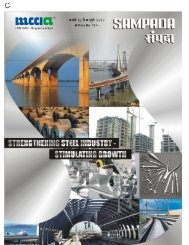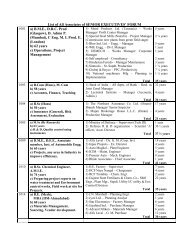read more... - Mahratta Chamber of Commerce Industries ...
read more... - Mahratta Chamber of Commerce Industries ...
read more... - Mahratta Chamber of Commerce Industries ...
Create successful ePaper yourself
Turn your PDF publications into a flip-book with our unique Google optimized e-Paper software.
President’s Message<br />
Dear Members,<br />
As I come to the end <strong>of</strong> my tenure as President <strong>of</strong> the <strong>Mahratta</strong> <strong>Chamber</strong> <strong>of</strong> <strong>Commerce</strong>, <strong>Industries</strong> and Agriculture (MCCIA),<br />
I am happy to share with you my thoughts, relating to the economic scenario, and to the <strong>Chamber</strong>'s role, on this occasion.<br />
The global economy, which was beset with an unprecedented recession in 2008 / 2009 mainly arising from reckless<br />
over-leveraging – by the Realty and Banking sectors in USA, has generally recovered to a significant extent. Nevertheless<br />
the growth rates in Europe and Japan continue to be disappointing. The US, though it has grown in GDP terms and<br />
employment terms, is not the strong engine <strong>of</strong> the global economy, that it till very recently, was. There is a real financial<br />
crisis in the Euro zone, mainly on account <strong>of</strong> disconnect between – on the one hand economic unity i.e. single currency,<br />
and on the other hand political disunity i.e. independent sovereign countries (with economic strategies and agendas<br />
that are very different). This is a difficult problem to solve. The world economy will be impacted severely if Europe cannot<br />
sort this out.<br />
The Indian economy, in the last couple <strong>of</strong> years has remained largely stable, though the growth rates have been<br />
noticeably lower than during the period before the global recession. The fundamentals <strong>of</strong> the Indian economy, in terms <strong>of</strong><br />
higher entrepreneurial spirit, growing demand, young population, robust banking system, a modernising rural economy,<br />
etc. have been the main causes for this relative stability in growth rates. However the industrial growth did experience a<br />
reduction coupled with much higher inflation than before the global crisis. The stock markets have recovered to a<br />
significant extent, yet two factors affect the sentiment on the bourses.<br />
1) Hesitation <strong>of</strong> global investors - international and Indian - to increase exposure to India, and<br />
2) Policy paralysis <strong>of</strong> the Government, coupled with numerous corruption scandals. Generally poor governance at various<br />
levels <strong>of</strong> government.<br />
The two are related. India can attract higher investments both from international investors and also domestic investors, if<br />
the sentiment about the health and prospects <strong>of</strong> the Indian economy can be restored.<br />
In this context it is important to recall that India's liberalisation <strong>of</strong> 1991 was based on 5 basic principles.<br />
a) Government would control fiscal deficit to below a level <strong>of</strong> 4.5 per cent – this meant imposing tight control on<br />
government expenditure, and improving productivity <strong>of</strong> government itself.<br />
b) Privatise business and encourage competition i.e. Government should get out <strong>of</strong> the log jam <strong>of</strong> its unproductive<br />
investment - in manufacturing industries, in trading businesses, in service enterprises - that it was not able, neither<br />
equipped nor competent to run. Commodity manufacture like steel production, also service industries like airlines and<br />
hotels, and manufacturing industries like textiles, electronics, etc. - were to be gradually privatised in a competitive,<br />
transparent and open environment, to improve the nation's productivity. This would also free government resources -<br />
for investment in core areas like infrastructure, defence, etc.<br />
c) Globalise the Indian economy i.e. open the economy to international trade, allow foreign investments, allow<br />
enhanced foreign trade, encourage Indian investors to invest abroad on sound business considerations. This was to be<br />
done in order to modernise Indian businesses, improve competitiveness and expose the country to the current<br />
technological and functional trends, in the global arena <strong>of</strong> trade and industry.<br />
d) Deregulate trade and industry i.e. Government was to get out <strong>of</strong> the way <strong>of</strong> entrepreneurs, to facilitate creation <strong>of</strong><br />
wealth as a priority. This was actually expected to foster genuine competition, and make India an attractive destination<br />
for investment.<br />
e) Create inclusive society i.e. improve infrastructure, physical and virtual - to connect the villages, the towns and the<br />
cities, open up the fields <strong>of</strong> education, enhance employment opportunities, enhance health care, etc. This was<br />
expected to provide the large mass <strong>of</strong> India's millions, with greater opportunities, and improved quality life.<br />
2
















